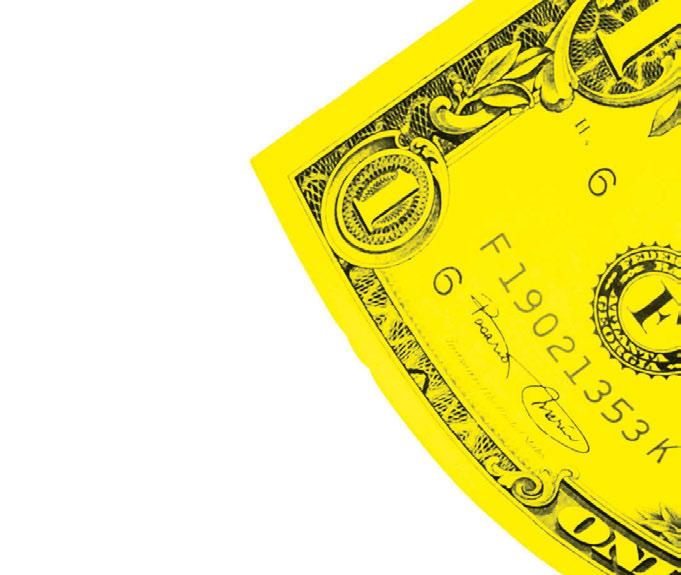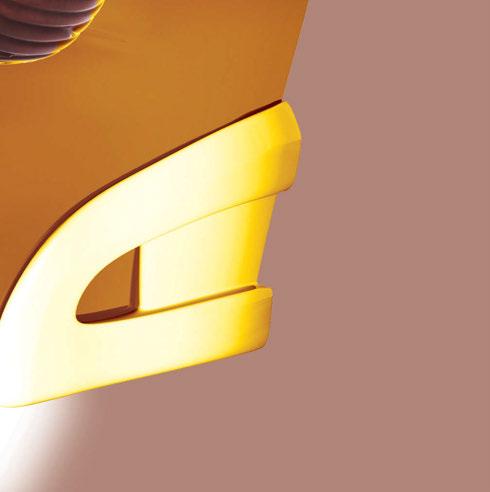
28 minute read
Food & Drink: What to eat the next time you’re in Pahrump
FOOD & DRINK
There’s more to Pahrump than meets the eye
By Lesl ie Ventura ou probably know about Pahrump’s annual balloon festival, its gun-loving ethos and its legal brothels, but the Nevada town some 70 miles west of Las Vegas isn’t particularly known for its dining scene. Look hard enough, however, and you might be surprised by what you’ll find out in the Mojave. Fancy driving an hour for a steak dinner? Or maybe you’d like to try some northern Indian food with a side of basketball? Pahrump has all that and more, just waiting to be enjoyed by bigcity folk from the east.
Pahrump Valley Winery (3810 Winery Road, 775-751-7800) is probably the area’s best-known culinary spot, along with the casual-but-upscale Symphony’s Restaurant. Menu items include pan-seared crab cakes ($13), baked imported Brie ($13) and a 6 ounce grilled filet mignon with a 6 ounce lobster tail and drawn butter ($47). The winery opened in 1990 and lost its first crop—in a bit of tragicomedy—when a legion of wild horses got hungry, but a few years later the winery made a comeback—“this time with a fence,” the website says. Since 2005, the Pahrump Valley Winery has touted itself as Nevada’s largest producer of homegrown wines, starting with Nevada’s first commercial red wine, the Pahrump Valley Zinfandel, and expanding to Merlot, Cabernet Sauvignon, Frontenac, Primitivo, Tempranillo and beyond.
The search for fine wine is just one reason to visit the desert town. The romantic Sanders Family Winery (3780 E. Kellogg Road, 775-727- 1776), located on the southern side of Pahrump, brings in live entertainment and food trucks regularly. Knock back a few bottles, find a motel and, in the morning, grab a fresh croissant at O Happy Bread (1231 E. East Basin Ave. #7, 775-455-0478), a bakery founded by Richard and Eliette Candillier in 2017. When the family from France came to the United States a few years ago, they saw the potential in the small Western town.
“They just packed everything up and moved here,” says baker Tony Britton. The Candilliers’ son, Julien, is the head baker, and they’ve enlisted other French chefs to handle breads and other bakery items. Locals love being able to get Y
fresh baked goods, soups and coffees “instead of the option of going to buy [something] readymade and microwaved,” Britton says.
Whatever you do, don’t leave town without hitting Pourhouse (1101 NV-160, 775-537-1111), a sports bar and Indian restaurant attached to the Best Western Pahrump Oasis. Manager Gurdey Rai says the response has been “mostly positive” since owner Sukhbir Dhillon bought the Best Western property and remodeled the sports bar—formerly known as Draft Picks—in 2017. “Some people, as far as the Indian food, are not willing to give it a try, but it’s been great and it’s working out,” Rai says.
Pourhouse still offers typical bar fare like burgers and wings, but it’s the northern Indian food that makes it an absolute must-stop. Where else in Pahrump can you find absolutely delectable and rich paneer tikka masala and lamb rogan josh at a sports bar? The answer is nowhere, and that’s exactly why you need to go.
Small but mighty
By Jason Harris Cubanidad 1885 brings island flavors to life
When we say Cubanidad 1885 is small, we’re talking three tables and a few counter seats. It feels like a secret you’ll want to be in on. Running the ship for the Cuban restaurant is Chef Dennis Martinez Miranda, who previously worked in his family’s restaurant in Venezuela and an upscale Latin fusion spot in Miami. On Cubanidad’s website, Miranda states, “The real secret [my secret] is in your heart—to follow your instincts.” Those instincts have resulted in some of the city’s best riffs on Cuban food. Flaky empanadas ($2.75 each) are a good way to start—or finish—any meal. The most interesting choice might be ropa vieja and plantain, though the simplersounding spinach and cheese is also a standout. The similarly textured Pastelitos Cubanos ($2.50) offer sweet fillings, including guava and cheese and sweet coconut. You can’t go wrong with either.
There are three iterations of the famed Cuban sandwich, if you include the Medianoche (midnight), which you should, because it’s a banger. Smoked ham, roasted pork, Swiss cheese and homemade mustard sauce comingle on pressed sweet egg dough bread, which plays perfectly against all those savory items.
You can also grab a filling plate featuring your favorite protein, like the aforementioned ropa vieja ($10)—shredded, stewed beef with an abundance of flavor—along with rice and a side. There are many to choose from, including sweet plantain maduros, sweet potato mash and fried yucca with mojo. Buen provecho, indeed. CUBANIDAD 1885 3585 S. Fort Apache Road, 702-846-5312. Daily, 11 a.m.-9 p.m. +
Cubanidad 1885’s empanadas (Wade Vandervort/Staff)
LBright I G

H
T
The fan experience should be bolder t han ever for Las Vegas soccer t eam’s t hird season
S
By Ricar do Torr es-Cort ez A n image of the scarf-wearing crew reflects off of Michael Denman’s aviator shades as soccer chants erupt from the Cashman Field bleachers on a crisp Saturday morning. It’s mid-January, two months before the Las Vegas Lights kick off their third season in the United Soccer League, and the team’s most faithful followers have already shown up—for an open house.
Denman, who sports the team’s yellow and blue colors on feathers attached to his bolero hat, is among a handful of seasonticket holders selecting their seats for the season ahead. Others, like the crew across the way, are cheering on hundreds of young athletes spread across the pitch for open tryouts. As coach Eric Wynalda runs prospective players through drills, the fan group rains down bass thuds, snare clacks and trumpet puffs, fine-tuning the techniques they’ll utilize for 17 regular-season home games starting March 14 against Sacramento.
Denman can probably rest easy on that front. Lights owner and CEO Brett Lashbrook says fan reaction has eclipsed expectations during the first two seasons. He points out that the Lights’ average of 8,000-plus fans per game ranks fourth among the USL’s 35 active franchises.
Lashbrook has emphasized the fan experience while keeping tickets affordable, the key to keeping what he calls “the people’s sport” thriving in Southern Nevada. Season-ticket prices actually went down this year and start at $200, which includes an official Lights jersey that retails at $80. That sort of value helped turn Denman into a soccer fan. The college history instructor, who describes himself as a nerdy, arty theater kid, says he began taking an interest in the sport just as the team arrived in Las Vegas. Denman followed from afar during the first season, then attended a few games last year, when he became hooked and sprung for 2020 season tickets.
He says he likes to arrive 45 minutes before the first whistle, often attending with his father so they can “take in the atmosphere” outside the stadium. Each game includes a fan fiesta boasting live music, food and games for children.
The excitement increases inside, where pregame ceremonies include appearances by the team llamas—Dollie and Dottie—and the motorcycle-riding, Elvis-impersonator mascot, Cash the Soccer Rocker. The Lights regularly schedule fireworks shows and have even hosted helicopter cash drops for fans the past two seasons.
Lashbrook promises even wilder promotions this season, describing his plans as “bigger, better and bolder, with more swagger and moxie—and a whole lot of confetti.” Once the teams hit the field, fans get a taste of what it’s like to watch a match in soccer hotbeds like Mexico City, London or Buenos Aires, Argentina, surrounded by exhilarated fans and enveloped by colorful smoke. With so many other sports options now available in Las Vegas, Lashbrook says the Lights have to be aggressive in carving their own niche. He can’t promise wins on the field—though he expects an improvement from last year’s 11-15-8 record—but he says he can guarantee smiling faces off of it. Even on a chilly day in January, the family atmosphere at Cashman is evident. Cash the mascot is high-fiving children. A few fans not banging on drums are waving oversized flags.
Jenny Garst is taking it all in. She says she used to dislike soccer enough to make fun of it, but everything changed when she went to a Lights game. Now she’s known for dragging along friends—like Patrick Hawkinson and Roberta Ward, who have joined Garst to watch tryouts.
Even if you haven’t been turned on to soccer yet, they say, Lights games are an event in their own right. “Why wouldn’t you come down?” Garst asks.
Got milk alternatives?

Breaking down the nutritional value and environmental impact of the various versions
By Kelcie Greg a f you grew up in the ’90s—or have kids who did—you surely remember the “Got milk?” campaign. Posters featuring celebrities—from Britney Spears to Kermit the Frog—plastered school hallways and lunchrooms, reminding those who walked by how milk helps growing bones stay healthy and strong. Two decades after those two words entered our consciousness, it might be time to rethink what kind of milk—if any—we should be drinking. Some studies dispute the necessity of milk for adults. Some people can’t tolerate it at all, but most who have a bad reaction to milk aren’t allergic to it, says Dr. Evelyn Montalvo Stanton, a pediatrician at the UNLV School of Medicine. They just have difficulty digesting lactose, a sugar found in dairy products. And lactose intolerance can increase with age, with only 40% of the population able to digest lactose into adulthood.
Some ethnicities are more lactose intolerant than others. Those of African, Asian and Ashkenazi Jewish descent, for example, have a higher lactose intolerance rate—between 75% and 90%— I
than those of northern European descent (18% to 26%).
Other types of milk aren’t hard to find, but the nutritional differences are vast. Plant-based soy milk, for example, is a good alternative for those with a dairy allergy or lactose intolerance, but doesn’t provide as much protein or riboflavin, aka vitamin B2.
There are environmental concerns to take into consideration, too. Almond milk, which has seen a massive spike in consumption over the past five years for being a low-calorie, vegan alternative, is easy to find in grocery stores and coffee shops, but some argue it negatively impacts the ecosystem, particularly for bees. The Guardian recently reported that “50 billion bees—more than seven times the world’s human population—were wiped out in a few months during winter 2018-19,” partially attributable to “America’s reliance on industrial agriculture methods, especially those used by the almond industry.”
In other words, there’s a lot to weigh when it comes to choosing the right kind of milk. Here’s a guide to help you decide …
Cow’s milk
It’s the most common and familiar variety, and it provides vitamins and minerals like vitamin D, calcium and potassium. Regular milk can be high in saturated fats, however, so most health officials recommend drinking a nonfat version.
Additionally, the protein in cow’s milk is a common allergen, so some doctors prefer lactose-free milk— cow’s milk with added enzymes that break down lactose into more digestible sugars. Also worth noting: One glass of cow’s milk can have at around three times the environmental cost of a glass of nondairy milk, according to a 2018 Oxford study.
Almond milk
Unsweetened almond milk is a popular vegan alternative for its silky, nutty taste, and reduced calories and carbs per serving. It’s rich in antioxidant vitamin E but low in protein. Some brands are fortified with added vitamins like A and D, but that varies from brand to brand.
In addition to its potential impact on bees, almond milk has other environmental effects. For example, it requires a lot of water to produce—more than one gallon of water per almond, The Guardian reported.
Hemp milk
Hemp milk is made from ground, soaked hemp seeds and is high in healthy omega-3 and omega-6 unsaturated fats. Hemp seeds are also one of the best sources of plant-based proteins and contain more calcium than dairy milk, according to U.S. News and World Report. Like almond milk, hemp milk has a nutty flavor with a creamy consistency, somewhat thicker than skim milk and other milk alternatives. Hemp milk is typically low in carbs, and it’s best to look for unsweetened brands. Oh, and for those wondering, no, you won’t get high on hemp milk, which contains only trace amounts of THC, the compound in marijuana that produces psychoactive effects.

Coc onut milk Coconut milk is a popular alternative for its taste and creamy consistency, but it’s high in saturated fats compared with dairy and soy milk. Some brands are fortified with protein and essential vitamins and minerals to increase the nutritional value. It’s also a safe, dairy-free alternative for those with nut or tree allergies, and some argue drinking coconut milk can boost good cholesterol levels.
Soy milk
Soy comes closest to dairy milk nutritionally, since soybeans are a good source of protein, according to a 2017 study published in the Journal of Food Science and Technology. Soy milk also contains cancer-fighting agents like isoflavones, and uses less water and land while producing fewer carbon emissions than cow’s milk, making it a more environmentally conscious choice. It has limitations, however, particularly for those with soy allergies. Soy milk contains compounds known by some as antinutrients, believed by some to have detrimental effects on digestion.
Oa t milk Oat milk can be a strong alternative for those looking for something higher in fiber, and also a great option for those with soy and nut allergies. Commercial oat milk brands are generally fortified with vitamins A, D, B2 and B12, along with minerals like calcium. The production of oat milk has a less-adverse environmental impact than almond or soy milk. But oat milk is generally higher in calories and carbs, and contains less protein than soy or dairy milk.
2020 Park Center Drive Las Vegas, NV 89135 FOR RESERVATIONS CALL (702) 7496966 trattoria-reggiano.com
Filet Mignon Meatballs

DOWNTOWN SUMMERLIN
20% OFF your bill with this ad* *May not be used in conjunction with any other off er or discount. Coupon must be present at time of purchase. Expires 12/31/20.







Biggest THE DAY’S News
DOWNTOWN SUMMERLIN
CALL AHEAD AT (702) 4766726

Straight To Your Inbox





Sign-up Now at LVSun.com/Optin


sthe best option for funding services, Is $ a l e



When Clark County Commissioner Tick Segerblom voted to raise the county’s sales tax by an eighth of a percent in September, he knew he was increasing a regressive tax that disproportionately impacts low-income individuals. But the tax hike was one of the only ways the county could boost funding for education and homelessness, two areas commissioners say are in need of extra cash, according to Segerblom.
“If we could raise the corporate income tax, the mining tax, things like that, that would be great,” he said. “But short of that, the simplest and fastest way to raise money is unfortunately the sales tax.” The commission-approved tax hike brings the sales tax rate in Clark County to 8.375%, an all-time high in Nevada. In the next two years, it could go up even more; the Clark County Education Association (CCEA) is petitioning to raise a portion of the sales tax, known as the local school support tax, by 1.5% to boost public education funding.
With the Legislature having failed to allocate substantial new revenue to education during the 2019 session, another sales tax hike might be the BY MIRANDA WILLSON
best, most immediate way to increase funding, said CCEA Executive Director John Vellardita. Those criticizing the union’s attempt to raise the sales tax should recognize that lawmakers have not identi ed an alternative funding source for schools, he said.
“We haven’t seen any e ort, any voice, any activity over the last several [legislative] sessions led by those who criticize it as regressive to change the way it is now,” Vellardita said.
These recent e orts to raise the sales tax appear to be part of a larger, years-long pattern in Nevada. Regressive and unstable due to its dependence on consumers’ volatile spending habits, the sales tax has nonetheless been the largest tax-generated source of revenue in Nevada for years. Between 2019 and 2021, 29.6% of all revenue in the state’s general fund was raised through the sales tax, according to the Department of Taxation’s annual revenue report.
But three trends are creating challenges for the state’s reliance on the sales tax, said Jeremy Aguero of the Nevada-based nancial consulting rm Applied Analysis.
One pertains to the types of goods subject to the tax in Nevada. With the state’s sales tax base already one of the narrowest in the country, recently approved sales tax exemptions for food, medical equipment and feminine hygiene products have slimmed that base down even more, Aguero said.
There are ethical questions to consider when taxing those products, since most consider them to be necessities. But taxing them also made sales tax revenue more resilient in times of economic downturn, said Marvin Leavitt, a former state lobbyist and former director of nance for the City of Las Vegas.
“If you have a recession, people still buy food, but they don’t buy other things. So [exemptions] make the tax less stable,” Leavitt said.
Additionally, more Nevadans are spending their income on non-taxable services rather than goods, Aguero said. Unlike many states across the country, services in Nevada—attorneys, electricity, re

xthe best option for funding services, t a or is it the only one?

pairs and more—aren’t taxed.
“There have been discussions about trying to apply the sales tax rate to services, but it has never happened,” Leavitt said.
Finally, property taxes—the other major source of revenue for local and state governments historically—haven’t been rising at the same pace as the sales tax. In fact, they can’t by state law.
Amid rapidly increasing property values and taxes in the early 2000s, lawmakers passed two laws in 2005 to ease the burden for taxpayers, Leavitt explained. Under the laws, residential property taxes cannot increase by more than 3% annually, and other property taxes cannot go up by more than 8% annually.
While the measures were bene cial to taxpayers at the time, the bene ts have been less apparent since the Great Recession, Leavitt said. During that period, property values plummeted, as did property taxes, but once the economy began to bounce back, property tax revenue could only increase incrementally. “If a house was valued at $300,000 and the value went down to $200,000, the property taxes would decrease,” Leavitt said. “But then if property values increased, we were limited on how much [taxes] could grow in any one year.”
The limit on property tax growth applies statewide, but fast-growing counties like Clark and Washoe have been a ected the most by this, he said.
One of the reasons Nevada has historically relied heavily on sales taxes is because of the state’s high number of visitors. While property taxes are only applied to permanent residents, the more than 40 million people who visit Las Vegas every year contribute to sales tax revenue through in-state purchases, reducing residents’ overall tax burden. But that point is becoming less compelling when looking at visitation and population trends, Aguero said. Because of Southern Nevada’s ballooning population and declining growth in visitation, the number of visitors per permanent resident is going down. As the state continues to diversify






its economy to rely less on hospitality, this trend could become more pronounced, he said.
Nonetheless, revenue from the sales tax overall has been on the upswing over the past year or two. Sales tax revenue brought in $1.09 billion to the state in scal year 2018, a 4.8% increase from the year prior.
Aguero attributes that high revenue to the taxation of internet sales, approved with a 2018 Supreme Court ruling. A spurt of high-budget construction projects, such as Resorts World and Allegiant Stadium, have also generated substantial revenue because construction materials are subject to the sales tax, Aguero said. The question he posed was whether that trend would sustain itself over the long term, especially if the economy su ers.
As far as Leavitt is concerned, it’s time for lawmakers to examine the state’s tax system, including sales and property taxes. “There are a whole bunch of things, I suppose, that sometime in the future, the Legislature needs to do a lot of work on to see if we have the right mix based on the way the current economy is,” Leavitt said.
But until changes are made, local lawmakers and advocates will continue to push for more revenue for services when needed, even if it’s done through the sales tax. The CCEA hopes to resolve a legal challenge from the Metro Chamber of Commerce to its proposed local school support tax increase and to secure enough signatures from residents to bring its proposal to the Legislature in 2021, Vellardita said.
“In lieu of an alternative, how are we going to fund our schools?” he asked.








With concussion concerns on the rise, high school football o cials and scientists focus on ways to increase safety
HEAD GAMES







High school football players in Nevada aren’t allowed to practice in shoulder pads and helmets until a few weeks before the season starts. Even then, athletes are required to practice without pads for three days before the transition—which, of course, brings on tackling.
In total, there are 10 practices before an athlete can participate in a game, an introductory time state athletic o cials say is vital in helping limit injuries. “Coaches are trained on concussions, which bring further awareness to the issues,” says Rich Muraco, Liberty High School’s football coach and president of the Southern Nevada
High School Football Coaches Association. “Thank God we have trainers, because it takes a lot of pressure [o ] us.”
High school sports participation is trending down for the rst time in 30 years, and a national decline in football participation is a signi cant reason why, a survey conducted by the National Federation of State High School Associations (NFHS) reveals.
Even though the number of schools o ering football has remained steady, participation dropped to 1,006,013 in the 2018-19 school year, the lowest mark since 1,002,734 for the 1999-2000 school year, according to the federation. That’s partially due to concerns surrounding the risk of injury, such as concussions and other more severe traumatic brain injuries, federal o cials noted. One recent peer-reviewed study reported that concussion rates during high school football games are on the rise. The study, released in October by Pediatrics, the of- cial journal of the American Academy of Pediatrics (AAP), concluded that football had the highest concussion rate at 10.4 per 10,000 exposures, followed by girls’ soccer at 8.19 and boys’ ice hockey at 7.69.
But Donnie Nelson, assistant director of the Nevada Interscholastic Activities Association (NIAA), says high school football is safer than ever before. “Our leaders at the NFHS have returned that there is a decreasing number of concussions in practices as well, because of the limited time designated for full contact [drills, plays, etc.],” he says. “The preseason policies adopted by our NIAA schools have our coaches saying the same things.”
It’s important to note that researchers from the AAP study concluded that while concussions during games were on the rise, concussion rates during practice have declined over the past ve years. In Nevada, football concussion rates have taken a slight dip, from 102 cases in 2015 to 96 cases in 2018.
In Nevada, participation in high school football has also been on the rise since bottoming out in 2017 at 6,781. In 2019, that number rose to 8,147. Nelson notes that some schools in Nevada have doubled their teams, so the number is probably closer to 7,400.
“We believe the football participation number will continue to grow, as the youth leagues also seem to be rebounding after their low some ve to seven years ago,” Nel



son says. “The increase in youth participation numbers is trickling up now.”
For that, Nelson credits the way gameplaying rules and strategies have evolved over the years.
Ahead of the curve In 2011, Nevada enacted a law requiring the NIAA to adopt guidelines and protocols to address sports injuries like concussions. Athletes who exhibit signs or symptoms that appear consistent with a concussion—loss of consciousness, balance problems, headache, dizziness or confusion—must immediately be removed from games or practices, returning only until after they have been cleared by a quali ed health care professional.
Nevada schools were ahead of the issue before these rule changes. In 2004, the Clark County School District instituted the ImPACT evaluation system to clear athletes for concussion before going back onto the eld. ImPACT, an online tool, tests each athlete’s memory, attention span and problem-solving skills. Players are then required to go through a series of additional balance and physical stress tests.
Muraco says NFHS encourages rugbystyle tackling, done by driving a shoulder into an opposing player’s hip, wrapping him up and taking him to the ground while the defensive player keeps his head to the side of the body.
Muraco, who has also coached wrestling, baseball, track and eld and ag football, says concussions were generally taken seriously if players exhibited more extreme symptoms such as dizziness, light sensitivity or loss of consciousness. “Even the kids themselves wouldn’t report the lesser symptoms,” he says. “When things didn’t stand out as obvious, we didn’t know any better, so we may have rushed some kids to play that we shouldn’t have.”
Coaches now receive training on how to detect concussions, and Clark County schools also have athletic trainers to assess a player’s injury. “We really were one of the top districts in the country when it came to the concussion protocol and identifying player safety,” Muraco says.
Concussion study While there have been strides made in the sports industry with regards to mitigating the risks associated with concussions and traumatic brain injury, there are still quite a few unknowns when it comes to brain injuries in athletes.
Concussions can range in severity and are often unpredictable, UNLV researcher Je erson Kinney says. The founding chair of the school’s brain health department, Kinney explains that concussions can cause subtle di culties in cognitive function or motor coordination, along with memory loss and behavioral problems. It’s a subject Kinney hopes to tackle through a collaborative e ort with the Cleveland Clinic Lou Ruvo Center for Brain Health and Indiana University.
Kinney says he believes the keys to diagnosing these injuries are blood-based biomarkers—proteins in the blood that can be used to indicate the presence of a disease. He plans to build upon the research his team has already done studying mixed martial arts ghters, which has shed some light on the di erence between athletes and control groups. The next step is to turn the research into a systemic investigation.
Kinney says, in particular, he hopes to understand whether one massive blow to the head has more severity than several, smaller sub-concussive blows. “When someone loses consciousness, everyone understands that’s a problem,” he says. “But if it’s a small blow, oftentimes trainers and coaches can’t detect it. Each may vary in the level of severity, but there may be some carryover, which may lead to a problem.”
Above water Welcome to St. Thomas, the former town drowned by Lake Mead

Many Nevada ghost towns were rapidly established by miners and prospectors and abandoned as soon as the mines dried up. But St. Thomas, founded in 1865 as a Mormon farming outpost, was ultimately abandoned for a less typical reason: It was about to drown.
The development of the Hoover Dam and subsequent formation of Lake Mead submerged St. Thomas in 1938, forcing the town’s residents to flee. The remains of the former town, located in Lake Mead National Recreation Area near Moapa Valley, stayed underwater until 2003, when extreme drought caused the lake to recede enough to re-expose the area.
Since then, the ghost town has become a tourist attraction and an occasional reunion site for the descendants of former residents, most of whom relocated to Overton and Logandale in Moapa Valley.
“There are quite a few of them still around,” says Robin Maughan, executive director of the Old Logandale School Historical and Cultural Society in the town of Moapa Valley.
In 2019, National Park Service staff installed interpretive signs along the 2.5-mile St. Thomas trail to give visitors more information about St. Thomas’ history. The trail follows the former streets of St. Thomas and features the remains of building foundations, water-damaged but prominent.
Working with local historians, former residents and their descendants, the National Park Service identified the owners and uses of almost all the buildings still visible in the ghost town. Visitors can now view the remains and images of the original buildings side by side thanks to the interpretative signs.
“A lot of what we know about this area is from spoken word,” says Chelsea Kennedy, public affairs officer for Lake Mead National Recreation Area. Although St. Thomas was established by Mormons who thought they were still in Utah, those inhabitants left the settlement six years later after the state borders were adjusted. Other settlers moved into the area during the years that followed.
In its heyday during the late 1800s to early 20th century, St. Thomas had a school, a general store, a post office, a blacksmith shop and a hotel. Its peak population was 500, and industries included salt mining and agriculture. The town was also a stopping point on the first automobile route between Salt Lake City and LA, known as the Arrowhead Trail, Kennedy says.
In 1928, President Calvin Coolidge authorized the construction of what would become the Hoover Dam. Promised compensation by the federal government, residents began to move out, often dismantling their homes to reuse the valuable building materials. By 1935, the water started rising, and By Miranda Willson | Photograp hs b y Steve Marcus






